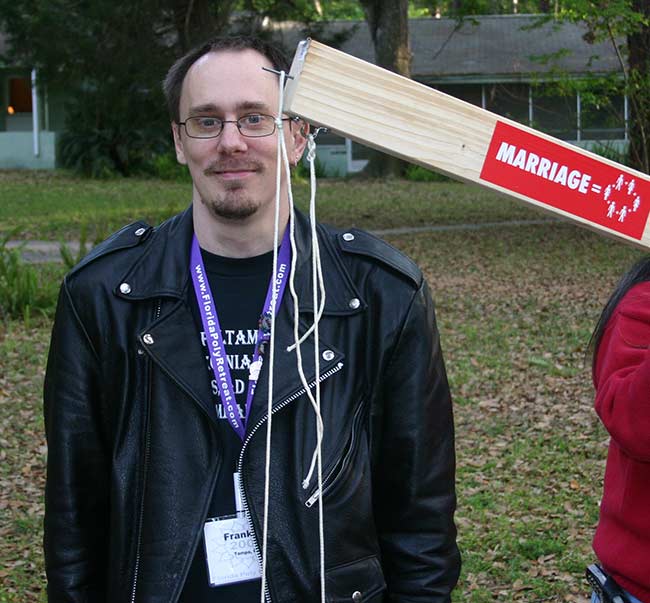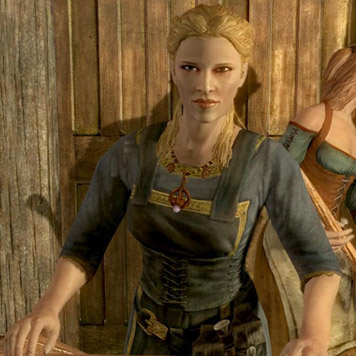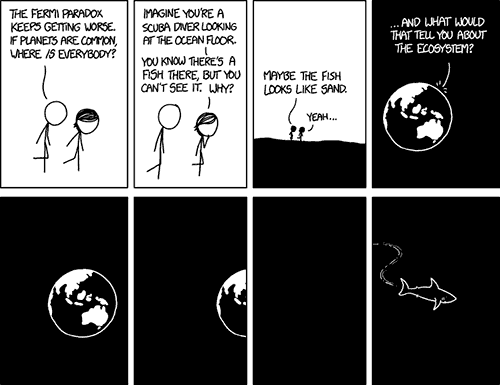Three days ago, I celebrated my fiftieth birthday.
Well, perhaps “celebrated” is too strong a statement. I was in the middle of an allergy attack that made me miserable, so I spent it faffing about on the computer rather than engaging in the kind of orgiastic bacchanal that one might expect from an Internet sex gargoyle.
In any event, in between faffings on the Internet, I spent some time musing about what an absolutely bizarre trip it’s been, and some time cleaning in my writer’s loft. These two things are related, as it turns out, because in the process of cleaning I came upon some old photographs.
I started the journey through life in New Jersey. Before I was a year old, I realized that living in New Jersey was a bit rubbish, so I moved to Idaho, taking my entire family with me. My parents drove a Volkswagen Bug, something which apparently left quite an impression. What can I say? I was struck by the elegant simplicity and robustness of the design.
We stayed in Idaho long enough for me to pick up a sister, then bounced around the Great Midwest for a while, where I picked up the hobby of model rocketry. There is, it seems only one battered and scuffed Polaroid photo exists from this particular time in my life–peculiar, when one considers that model rocketry was pretty much the greatest thing in my life for quite a long time.
And yes, that’s a plastic model of a Romulan bird of prey from the original Star Trek on my desk. Don’t judge me.
I had a computer back then as well, a Radio Shack TRS-80 Model 1 that was a Christmas gift from my aunt in 1977. That thing might have saved my sanity. I didn’t have any friends while I was growing up in Venango, Nebraska, but who needs friends when you have a computer and a bunch of rockets?
Radio Shack published the complete schematic of the TRS-80. Seriously, you could walk into the store and buy not only the schematics but also books on how to modify it, and a complete, commented disassembly of the ROM chips–something that is beyond unthinkable today.
I modified the computer extensively, spray-painted it black, and overclocked it. Stock, it had a 1.77MHz Z80 8-bit processor, which I modified to work at 2.44 MHz (which caused some software to break) or at approximately 4 MHz (which caused it to malfunction frequently and required that I set it in a tray full of plastic bags of ice). The yellow LED you see in this photo would come on when I ran it at 2.44 MHz, the red LED would come on at 4 MHz. My parents were often horrified to see it spread out all across my bed, which was the only work space I had.
I kept it until I was almost 40, purely from nostalgia.
In my memoir The Game Changer, I talk about taking two dates to my high school senior prom. This wasn’t because I was suave with the ladies; it was because one person asked me to the prom, I said yes, another person also asked me, I said yes again, and it didn’t even occur to me that this might be a problem.
Fortunately, they were both totally cool about the whole thing. I took them both to dinner before the prom, which raised a few eyebrows.
Only two photos from that prom exist that I’m aware of, and I found both of them. Yes, I’ve always been a weird-looking motherfucker.
Until recently, I have not been much into partner dancing, though I do love to dance. My high school senior prom might’ve been the last time I partner danced until I was in my 40s.
I had a storied checkered educational career. I went to school at Lehigh University, where I discovered, and feel in love with, a Digital Equipment Corporation DECsystem-20 mainframe. Ours was a forbidden love. There were certain…allegations from the faculty of less-than-completely-aboveboard activities involving that mainframe. “Computer hacking,” they said. Also, “your scholarship is revoked.” And “don’t come back.”
I bounced around for a bit, worked fast food for a while, then ended up going to school in Florida again. Sadly, that part of my life is poorly documented–if any photos exist from that period, I don’t have them.
I did find this photo of me, taken in April of 1991, the last year I was in college.
My early childhood experience with my parents’ Volkswagen led to a long-term love for the cars, of which I’ve owned two. The first car I ever owned was a 1969 Bug; my third car was a 71 Bug, which, like my computer, I modified extensively.
There’s a passage in The Game Changer in which I talk about how absolutely clueless I was about sex and relationships, and how I could not recognize even the most obvious attempts at flirting:
Worse, I was in that awkward stage of male development where I was so desperate to try to figure out how to get girls to pay attention to me that I completely missed it when girls paid attention to me. Prior to that afternoon at Jake’s place, Caitlin and I had spent quite a lot of time together. We were great friends. But when I look back with wiser eyes, I can see she was trying in a thousand ways to tell me she was open to more.
One particular evening, I drove her home from work in my beat-up Volkswagen Bug. We sat in the car in front of her house talking for a while. She complained there was something on the seat digging into her butt. She dug around for a bit and came up with a small machine screw—a leftover, no doubt, from the work I’d just done replacing the back fenders with the half-sized fenders popular among people who liked to take Volkswagens through deep mud. “Hey!” she said brightly, holding it up. “Wanna screw?”
The whoosh of her flirt passing over my head might have sucked all the air out of the car had the windows not been open. It was years before I realized she’d been flirting with me all along.
This is the car in which that happened.
From about 1978 or so on, I had been involved heavily in the computer BBS scene. A BBS was the forerunner of modern Web forums–a computer running special software connected to a phone line, which you could dial into and leave messages on (text only, generally) at agonizingly slow speeds. Most BBS systems could only accommodate one user at a time, so if you called while someone else was logged on, you’d get a busy signal. Popular systems were constantly busy, so you’d set your computer up to keep redialing, over and over, until it got through, then alert you when it made a connection.
I was on systems with names like CBBS-Chicago, Pirate-80, and Magnetic Fantasies. When I started school in Sarasota, I ended up with a roommate who was, like me, an enthusiastic TRS-80 hacker and BBS fan. He ran a BBS called The Wyvern’s Den. I thought “hey, I can do that!” and started a BBS of my own, called a/L/T/E/R r/E/A/L/I/T/Y.
I ran A/R for about six or seven years, on a TRS-80 Model 4 that had been heavily modified. The IBM PS/2 computer had just come out, and the PS/2 systems used 3.5″ floppy drives that had a design defect: they were prone for going out of alignment. IBM would replace them under warranty and then, rather than taking the five minutes to fix the floppy drives, would just throw them out. I went Dumpster diving behind an IBM repair shop one evening, came out with a big pile of 3.5″ floppy drives, cleaned them up, aligned them, and connected them to the TRS-80 by way of a custom hardware interface I designed and built. These became the storage for the A/R message boards. You can see two of them, sitting bare without cases, to the right of the computer in this photo. There’s a third one sitting on the shelf just behind the center of the computer, and a fourth one under the 5.25″ floppy in the foreground on the right.
TRS-80 floppy drive controllers were only supposed to be able to access four floppy drives, but it turned out to be possible to instruct the floppy controller to access two drives at the same time, so with a bit of software trickery and a 4-line-to-16-line demultiplexer chip, you could actually get them to talk to up to 16 drives at once.
There’s a wooden box just barely visible in the right-hand side of the picture. It held a power supply that powered all the floppy drives. I used to warn guests to the apartment, “don’t touch that, you’ll get electrocuted.”
I was a late bloomer sexually, but made up for it through the rest of my life. In the late 90s, I developed a prototype of an Internet-controlled sex toy. It rose up out of a toy I’d developed in the mid-90s that was designed to be plugged into a telephone line and controlled by the tones from a Touch-Tone phone. My former business partner and I tried to bring it to market, with less than stellar success.
We designed a plastic cabinet for it, which we made with a vacuum-forming rig we built. We had a run of circuit boards made, and I would sit for hours at the kitchen table with a soldering iron in my hand putting components on them. The company we’d hired to fab the circuit boards made a mistake in the fabrication, so each board required reworking as well.
We called the device “Symphony.” This is the very first one we ever sold. It’s supposed to have the name “Symphony” screen printed on the front; somehow, this one ended up without the screen printing.
And now, decades later, Im still exploring the intersection of sex and technology.
From high tech to low tech: in the early 2000s, I was invited to speak at Florida Poly Retreat. One of the classes I taught was in how to build a trebuchet, a Medieval siege engine. During the course of that workshop, we designed and built a working model trebuchet.
The T-shirt I’m wearing in this photo reads “Catapultam habeo. Nisi pecuniam omnem dabis, ad caput tuum saxum immane.”
Even after my divorce from my ex-wife Celeste, which story forms the backbone of The Game Changer, I kept this habit of extensively hacking any computer I own. (That continues to this day; I’m typing this on a MacBook Pro that has had its DVD drive removed and replaced with a second hard drive, and the first hard drive has been replaced with an SSD.)
My partner Amber and I moved into an apartment together after the divorce. The living room looked like this.
I kept the TRS-80s and an Apple Lisa, even though they’d largely been retired by this point. The black thing stuck to the ceiling is an Apple //c monitor, spray-painted black. It had a green screen monochrome display that accepted a composite video signal, so it was easy to pipe just about any video into it. Most of the time, Amber and I had it showing Bladerunner on a loop. When I played World of Warcraft, though, I would pipe that to it instead.
Amber and I ended up rescuing two cats during the time we lived together. One, a rather handsome tabby, had climbed a tree to the third story of the apartment building next to ours, jumped from an overhanging branch onto the roof, and then realized he couldn’t get back down. He cried piteously for days. We threw food up to him until we could figure out a way to rescue him. We named him Snow Crash.
The other adopted Amber when we were out walking in a large park late one night. We heard a cat meowing from under some bushes. When we turned around, a cat came catapulting out straight for Amber and jumped up into her arms. She refused to let go, holding on to Amber until we walked all the way back to the car, then insisting on accompanying us home. We named her Molly, for the character Molly Millions in Neuromancer.
So here I am, fifty years old, and what a peculiar thing it is to be a human being. Life is amazing.
When I was a child living in Venango, the bus that took me to school would drive past a church with a sign out front that had pithy sayings on it intended to inspire us to live better lives. One day, that sign said “Your life either sheds light or casts a shadow.” I knew, at eleven years old, there was something wrong with that, but I didn’t have the words to describe what. Now, almost forty years layer, I understand: it’s bullshit. We are all, every one of us, made of light and shadow, good and evil.
I have screwed things up and hurt people. I have been hurt. I have gotten things wrong, made mistakes, been careless with the hearts of others.
I have also experienced the most amazing love. I have known and been loved by people who are so remarkable, I consider myself privileged merely to have known them. I have learned things and gotten some things right.
We are all made of light and shadow. It is on all of us to treat each other with care. We’re all confused. Being human is fundamentally weird and more than a little scary. We’re all making this up as we go along, even those of us–especially those of us–who try to pretend we Have It All Figured Out.
I’ve spent thirteen and a half billion years, give or take, not existing, and fifty years existing. That’s enough of a sample size to tell me that existing is better. It’s harder, sure. We have to do stuff. We have to make choices. You don’t have to make choices when you don’t exist. Making choices means sometimes we make wrong choices, and making wrong choices means sometimes we hurt people. Hurting people sucks.
I carry a lot of regrets with me. There are many things I have done that I wish with all my heart I could undo–times when I have not been as careful as I should be, perhaps too preoccupied with my own fears to be properly gentle with other people. It’s a consequence of being plonked into existence without a user’s manual.
We all get banged up a bit on the journey through life. But despite that, I would not trade a goddamn minute of it for anything. I am flawed and I make mistakes. All the people I know are flawed and make mistakes. And yet, this brief moment we share in the sun is a gift of inestimable value. I am grateful for every moment of it, and I hope to be here in existence for much, much more.
Like this:
Like Loading...









































 A particularly pernicious variant on this “women-as-victims” narrative is circulating amongst folks who are generally politically liberal and see themselves as allies of women, but still face discomfort about porn and sex work: Well, yes, women can and do freely choose to go into porn or sex work, but, you see, not abuse porn like what you see at
A particularly pernicious variant on this “women-as-victims” narrative is circulating amongst folks who are generally politically liberal and see themselves as allies of women, but still face discomfort about porn and sex work: Well, yes, women can and do freely choose to go into porn or sex work, but, you see, not abuse porn like what you see at  The starvation model of sex work starts with the assumption that it is hard to find people who want to do porn or sex work. A reasonable person wouldn’t make that choice, except through coercion or the most dire of necessity. Therefore, to feed the demand for sex workers and porn performers, there must be coercion and abuse.
The starvation model of sex work starts with the assumption that it is hard to find people who want to do porn or sex work. A reasonable person wouldn’t make that choice, except through coercion or the most dire of necessity. Therefore, to feed the demand for sex workers and porn performers, there must be coercion and abuse. Psychologists often talk about a quirk of human psychology called the fundamental attribution error. It’s a bug in our firmware; we, as human beings, are prone to explaining our own actions in terms of our circumstance, but the actions of other people in terms of their character. The standard go-to example of the fundamental attribution error I use is the traffic example: “That guy just cut me off because he’s a reckless, inconsiderate asshole who doesn’t know how to drive. I just cut that car off because the sun was in my eyes and there was so much glare on the windshield I didn’t see it.”
Psychologists often talk about a quirk of human psychology called the fundamental attribution error. It’s a bug in our firmware; we, as human beings, are prone to explaining our own actions in terms of our circumstance, but the actions of other people in terms of their character. The standard go-to example of the fundamental attribution error I use is the traffic example: “That guy just cut me off because he’s a reckless, inconsiderate asshole who doesn’t know how to drive. I just cut that car off because the sun was in my eyes and there was so much glare on the windshield I didn’t see it.” I would like to propose that there is another bug in the operating firmware of humanity, similar to the fundamental attribution error. Call it the fundamental construction error, if you will. We as human beings re-construct the world in our own image, assigning our own values, ideas, squicks, taboos, likes, and dislikes to the great mass of humanity as a whole. “Nobody likes,” “everybody wants,” “nobody would,” “everybody thinks”–all statements of this class can most properly be understood to mean “I don’t like,” “I want,” “I wouldn’t,” and “I think.”
I would like to propose that there is another bug in the operating firmware of humanity, similar to the fundamental attribution error. Call it the fundamental construction error, if you will. We as human beings re-construct the world in our own image, assigning our own values, ideas, squicks, taboos, likes, and dislikes to the great mass of humanity as a whole. “Nobody likes,” “everybody wants,” “nobody would,” “everybody thinks”–all statements of this class can most properly be understood to mean “I don’t like,” “I want,” “I wouldn’t,” and “I think.”





